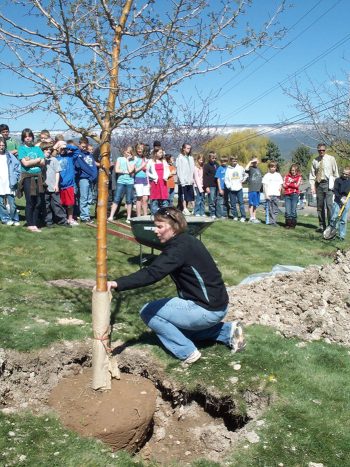
The Urban & Community Forestry team at the Colorado State Forest Service works around the state to increase tree equity and create healthy, resilient forests and communities in Colorado. Kamie Long, the CSFS urban & community forestry program specialist in Western Colorado, works closely with communities to help meet their needs and increase tree coverage in their area. Kamie recently hit a career milestone: She’s anInternational Society of Arboriculture Certified Arborist for 18 consecutive years and Tree Risk Assessment Qualified for 11 years. To celebrate this achievement, we asked Kamie to share her journey and her favorite parts of the job.

What inspired you to pursue a career in forestry?
I’m one of those lucky folks who have known from a young age, 8th grade, what I wanted to do as a career. Once I decided on forestry, I knew that I would go to Northern Arizona University to get my degree; it’s also where my dad received his forestry degree. After I graduated, I was thrilled to be hired on with the Colorado State Forest Service as a forester and I’ve been doing forestry work here ever since!
Once I started working for the CSFS I learned about urban forestry from some great mentors, Keith Wood and Vince Urbina, and realized how much I also enjoyed working with trees in our communities and educating people on how to take care of the trees that they see every day in their landscape.
What is your favorite part of your job?
As an urban forester, I really enjoy educating people about whatever question they are dealing with at the time, such as what species to plant, how to properly plant or prune trees or just a general question of what tree do I have? I also like working with communities to come up with ways to better educate/inform the residents on their urban forest and help understand the value of what they have growing around them.
Do you have advice for people wanting to explore forestry careers?
I have really enjoyed working in forestry, both traditional and urban. My advice is, especially for those in school, is to try a bunch of different internships and summer jobs throughout your school career. Take advantage of opportunities that come your way through professors or school groups like the Society of American Foresters. By taking different jobs you can learn which parts of forestry or natural resources you really enjoy (or not!).
What is your proudest accomplishment?
My most recent accomplishment that I’m proud of is updating the online Colorado Tree View (COTV) tree inventory database. It was a very basic tool, only collecting data on tree species, diameter, overall health and if it was a high-value ash tree. Now it’s a very robust inventory that includes questions about tree condition/health, tree management needs and observations that tree managers make decisions and assess tree risk. A community or organization, such as an arboretum, golf course or cemetery, can select the data their tree managers need to make informed decisions about tree care and budgets. Communities with large budgets likely had tree inventories, but this update to COTV helps smaller communities increase their awareness of what they have in their urban forest and how to better manage it.
Kamie is one of many arborists at the Colorado State Forest Service. We appreciate everything they do to help create healthy, resilient forests and communities here in Colorado. Learn more about Urban & Community Forestry.



Author:
Melanie Matthews, 2024 Communications & Communities Intern, Colorado State Forest Service

